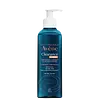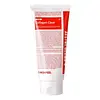What's inside
What's inside
 Key Ingredients
Key Ingredients

 Benefits
Benefits

 Concerns
Concerns

 Ingredients Side-by-side
Ingredients Side-by-side

Water
Skin ConditioningDecyl Glucoside
CleansingDisodium Cocoyl Glutamate
CleansingCeteareth-60 Myristyl Glycol
EmulsifyingSuccinic Acid
BufferingLactic Acid
BufferingDisodium Coco-Glucoside Citrate
EmulsifyingSodium Hydroxide
BufferingGlycerin
HumectantParfum
MaskingGlyceryl Laurate
EmollientCI 61570
Cosmetic ColorantLens Esculenta Seed Extract
Skin ProtectingPentylene Glycol
Skin ConditioningSodium Benzoate
MaskingCI 19140
Cosmetic ColorantWater
Skin ConditioningDipropylene Glycol
HumectantGlycerin
HumectantButylene Glycol
Humectant1,2-Hexanediol
Skin ConditioningIsopropyl Isostearate
EmollientNiacinamide
SmoothingSodium Hyaluronate
HumectantHydroxypropyltrimonium Hyaluronate
Caprylic/Capric Triglyceride
MaskingHydrolyzed Hyaluronic Acid
HumectantSodium Acetylated Hyaluronate
HumectantHyaluronic Acid
HumectantAcetyl Hexapeptide-8
HumectantSodium Hyaluronate Crosspolymer
HumectantHydrolyzed Sodium Hyaluronate
Skin ConditioningAstaxanthin
Skin ConditioningPotassium Hyaluronate
Skin ConditioningLavandula Angustifolia Flower Extract
CleansingSalvia Sclarea Extract
AntiseborrhoeicHyacinthus Orientalis Extract
Skin ConditioningChamomilla Recutita Flower Extract
MaskingBorago Officinalis Extract
EmollientCentaurea Cyanus Flower Extract
AstringentCarbomer
Emulsion StabilisingArginine
MaskingBeeswax
Emulsion StabilisingButyrospermum Parkii Butter
Skin ConditioningStearyl Alcohol
EmollientHydrogenated Polyisobutene
EmollientDimethicone
EmollientSorbitan Stearate
EmulsifyingPanthenol
Skin ConditioningPolysorbate 60
EmulsifyingPEG-40 Hydrogenated Castor Oil
EmulsifyingPalmitic Acid
EmollientC14-22 Alcohols
Emulsion StabilisingAmmonium Acryloyldimethyltaurate/Vp Copolymer
Hydrogenated Lecithin
EmulsifyingAdenosine
Skin ConditioningPolyacrylate-13
C12-20 Alkyl Glucoside
EmulsifyingTocopheryl Acetate
AntioxidantDisodium EDTA
Polyisobutene
Propanediol
SolventPolyglyceryl-10 Diisostearate
EmulsifyingEthylhexylglycerin
Skin ConditioningPolysorbate 20
EmulsifyingSorbitan Isostearate
EmulsifyingGlucose
HumectantCI 42090
Cosmetic ColorantParfum
MaskingHexyl Cinnamal
PerfumingAlpha-Isomethyl Ionone
PerfumingHydroxycitronellal
PerfumingCitronellol
PerfumingLimonene
PerfumingGeraniol
PerfumingLinalool
PerfumingWater, Dipropylene Glycol, Glycerin, Butylene Glycol, 1,2-Hexanediol, Isopropyl Isostearate, Niacinamide, Sodium Hyaluronate, Hydroxypropyltrimonium Hyaluronate, Caprylic/Capric Triglyceride, Hydrolyzed Hyaluronic Acid, Sodium Acetylated Hyaluronate, Hyaluronic Acid, Acetyl Hexapeptide-8, Sodium Hyaluronate Crosspolymer, Hydrolyzed Sodium Hyaluronate, Astaxanthin, Potassium Hyaluronate, Lavandula Angustifolia Flower Extract, Salvia Sclarea Extract, Hyacinthus Orientalis Extract, Chamomilla Recutita Flower Extract, Borago Officinalis Extract, Centaurea Cyanus Flower Extract, Carbomer, Arginine, Beeswax, Butyrospermum Parkii Butter, Stearyl Alcohol, Hydrogenated Polyisobutene, Dimethicone, Sorbitan Stearate, Panthenol, Polysorbate 60, PEG-40 Hydrogenated Castor Oil, Palmitic Acid, C14-22 Alcohols, Ammonium Acryloyldimethyltaurate/Vp Copolymer, Hydrogenated Lecithin, Adenosine, Polyacrylate-13, C12-20 Alkyl Glucoside, Tocopheryl Acetate, Disodium EDTA, Polyisobutene, Propanediol, Polyglyceryl-10 Diisostearate, Ethylhexylglycerin, Polysorbate 20, Sorbitan Isostearate, Glucose, CI 42090, Parfum, Hexyl Cinnamal, Alpha-Isomethyl Ionone, Hydroxycitronellal, Citronellol, Limonene, Geraniol, Linalool
 Reviews
Reviews

Ingredients Explained
These ingredients are found in both products.
Ingredients higher up in an ingredient list are typically present in a larger amount.
Glycerin is already naturally found in your skin. It helps moisturize and protect your skin.
A study from 2016 found glycerin to be more effective as a humectant than AHAs and hyaluronic acid.
As a humectant, it helps the skin stay hydrated by pulling moisture to your skin. The low molecular weight of glycerin allows it to pull moisture into the deeper layers of your skin.
Hydrated skin improves your skin barrier; Your skin barrier helps protect against irritants and bacteria.
Glycerin has also been found to have antimicrobial and antiviral properties. Due to these properties, glycerin is often used in wound and burn treatments.
In cosmetics, glycerin is usually derived from plants such as soybean or palm. However, it can also be sourced from animals, such as tallow or animal fat.
This ingredient is organic, colorless, odorless, and non-toxic.
Glycerin is the name for this ingredient in American English. British English uses Glycerol/Glycerine.
Learn more about GlycerinParfum is a catch-all term for an ingredient or more that is used to give a scent to products.
Also called "fragrance", this ingredient can be a blend of hundreds of chemicals or plant oils. This means every product with "fragrance" or "parfum" in the ingredients list is a different mixture.
For instance, Habanolide is a proprietary trade name for a specific aroma chemical. When used as a fragrance ingredient in cosmetics, most aroma chemicals fall under the broad labeling category of “FRAGRANCE” or “PARFUM” according to EU and US regulations.
The term 'parfum' or 'fragrance' is not regulated in many countries. In many cases, it is up to the brand to define this term.
For instance, many brands choose to label themselves as "fragrance-free" because they are not using synthetic fragrances. However, their products may still contain ingredients such as essential oils that are considered a fragrance by INCI standards.
One example is Calendula flower extract. Calendula is an essential oil that still imparts a scent or 'fragrance'.
Depending on the blend, the ingredients in the mixture can cause allergies and sensitivities on the skin. Some ingredients that are known EU allergens include linalool and citronellol.
Parfum can also be used to mask or cover an unpleasant scent.
The bottom line is: not all fragrances/parfum/ingredients are created equally. If you are worried about fragrances, we recommend taking a closer look at an ingredient. And of course, we always recommend speaking with a professional.
Learn more about ParfumWater. It's the most common cosmetic ingredient of all. You'll usually see it at the top of ingredient lists, meaning that it makes up the largest part of the product.
So why is it so popular? Water most often acts as a solvent - this means that it helps dissolve other ingredients into the formulation.
You'll also recognize water as that liquid we all need to stay alive. If you see this, drink a glass of water. Stay hydrated!
Learn more about Water